译者的话:
“眼见他起高楼,眼见他宴宾客,眼见他.....”,咱们今天说的不是楼房养猪,倒是另外一种超级接地气养猪方式--大棚养猪。大棚养猪的优势明显:小快省--单体地块需求小、启动资金相对封闭猪舍更少、猪舍建筑成本低、建设周期很短、功能切换很容易(养猪-不养猪),劣势也同样显著:更多的劳力、垫料&饲料消耗多等。本文详尽地陈述、分析大棚猪舍与封闭猪舍在建筑、运营、维护、效益等方面并进行比对,在生猪养殖模式方面展示了另外的一种可能性,对于有限资本想快速进入生猪养殖行业的投资者,大棚猪舍养殖不失为最佳选择之一,但是否适用与中国或者自己, 视各自掌控的资源而定。大棚猪舍--此地风景颇有奇异之处, 有请观瞻.....
大棚猪舍的建设和管理 (上)
Managing Market Pigs in Hoop Structures (Part 1)
作者 Authors
1Mark S. Honeyman
2Frederick Wm. Koenig
1Jay D. Harmon
1Don C. Lay, Jr.
1James B. Kliebenstein
1Thomas L. Richard
3Michael C. Brumm
1爱荷华州立大学 Iowa State University
2美国中西部计划委员会 MidWest Plan Service
3内布拉斯加大学 University of Nebraska
审稿人 Reviewers
Eldridge R. Collins, Jr.,
弗吉尼亚理工学院和州立大学
Virginia Polytechnic Institute and State University
Don D. Jones
普渡大学 Purdue University
引入Introduction
美国的养猪生产者正在寻找更低成本的养猪圈舍设施,而他们对大棚猪舍表现出了极大的兴趣。生产者需要意识到这种类型猪舍的优点和缺点。有许多建造商可提供此类型的猪舍,但几乎没有客观数据可用来帮助生产者决定大棚猪舍是否是一个好的投资。本文中旨在帮助生产者和设计者解决使用大棚猪舍所涉及的一些问题。本文讨论了大棚结构猪舍所需要的一些管理技术,并提出了可用于分析替代方案的经济因素。
Pork producers in the United States who are looking for lower cost structures for raising pigs have shown a great deal of interest in hoop structures or hooped shelters as facilities for housing market or finishing pigs. Producers need to be aware of the advantages and disadvantages of this type of housing. A number of manufacturers offer these units for sale, but little objective data are available to help producers decide if a hoop structure is a good investment. The information in this publication is intended to help producers and designers resolve some of the issues involved in using a hoop structure. The fact sheet discusses some of the management techniques that hoop structures require, and it presents economic factors that can be used to analyze the alternatives.
什么是大棚猪舍?
What Is a Hoop Structure?
大棚猪舍是一种半圆拱形活动房屋形状的结构,其侧壁由经过防腐处理的木柱子和木墙构成,高4英尺到6英尺(1.22-1.83米)。用管状钢拱固定在柱子的顶部或侧面,形成一个拱形屋顶,屋顶上覆盖不透明的、抗紫外线的聚乙烯醇防水油布。作为猪舍使用的大棚结构,其内部地面除了一块用于采食和饮水的水泥板之外,其他地方多是泥土地面。泥土地面会垫上深层垫料,并且每批猪上市后垫料会清理掉。
A hoop structure is a Quonset-shaped structure with sidewalls 4 ft to 6 ft high made from treated wood posts and wood sides. Tubular steel arches are fastened to the tops or sides of the posts to form a hooped roof, which is covered with an opaque, UV-resistant, polyvinyl tarp. When used for swine housing, most hoop structures have earthen floors except for a concrete slab feeding and watering area. The earthen portion of the floor is deep bedded and cleaned after each group of pigs is marketed.
图1是一个典型的大棚结构猪舍,图2是大棚猪舍的基本结构构成。大棚猪舍是自然通风的,建设时,应该考虑并利用夏季主风向。
Figure 1 shows a typical hoop structure and Figure 2 shows the common components of a hoop structure. Hoop structures are naturally ventilated and should be sited to take advantage of prevailing summer winds.
图1:典型的大棚结构猪舍
Picture 1: Typical hoop structure
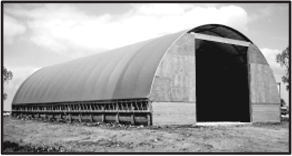
优点Advantages
大棚猪舍对下列养猪生产者来说是有优势的:
Hoop structures are most beneficial for producers who:
• 需要通用型猪舍设施,以适应快速变化的养猪业。
Want facilities with versatility to match a rapidly changing swine industry.
• 需要一个可满足短期使用的猪舍结构,使用后可以拆除,或可以用于其他用途。
Need a short-term structure that can be removed after use or that can be adapted for other uses.
• 希望保持较低的固定成本。
Want to keep fixed costs low.
• 资金有限。
Have limited capital.
• 不能接受大型资本投资相关的额外财务风险。
Are not interested in accepting the additional financial risk associated with a large capital investment.
• 愿意处理固体粪污并且有能力这样做。
Prefer to handle solid manure and have the capability to do so.
• 希望工作环境中的粪污气体含量低。
Want a working environment with lower levels of manure gases.
• 有设备和土地资源,能收获农作物残体(秸秆等)用作垫料。
Have the equipment and land resources to harvest crop residue for bedding.
• 愿意选择自动化程度较低、需要更多专业畜牧技能的生产系统。
Prefer a system of production that is less automated and requires more specialized husbandry skills.
• 相信猪应该在有垫料的环境中饲养。
Believe pigs should be reared in an environment with bedding.
• 需要能够快速搭建的猪舍结构。
Need a structure built quickly.
图2:大棚猪舍的基本结构构成。妊娠母猪舍。
Figure 2: Common components of hoop structures. Source: Based on Figure 2, Hoop Structures for Gestating Sows, AED-44.
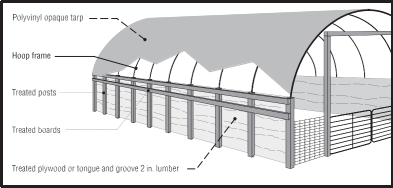
缺点Disadvantages
• 猪群大,难于观察猪只。
It is more difficult to observe animals in large groups.
• 大棚猪舍中的猪饲料效率较低。
Hoop pigs may use feed less efficiently.
• 恶劣天气下的工作环境较差。
Less favorable labor environment during inclement weather.
• 大棚猪舍中的猪可能比封闭式猪舍中的猪瘦肉率低。
Hoop pigs may be slightly less lean than confinement pigs.
• 大棚猪舍可能比封闭式猪舍需要更多的劳动力。
More labor may be needed for hoops than confinement.
• 大棚猪舍需要大量的垫料。
Hoops require large amounts of bedding.
• 收割垫料的劳动需求可能与收割农作物的劳动需求相冲突。
Labor needs for bedding harvest may conflict with grain harvest labor needs.
• 储存的垫料可能被浣熊和其他动物用作栖息地,从而可能会促进疾病在猪场间传播。
Bedding storage may be used by raccoons and other animals that may foster farm-to-farm disease transmission.
• 大棚猪舍很难杜绝可能携带疾病的鸟类和其他动物进入。
It is difficult to exclude birds and other animals that may carry diseases.
表1对各种不同类型的育肥舍进行了比较。对于那些不愿意或不能投资于封闭式猪舍、但又想把猪只从户外露天的养殖模式或Cargill式棚舍(Cargill式棚舍:5.5米宽*36.5米长的单坡棚舍,外面有一个混凝土区域。猪舍可容纳400头猪。饲料和水在室外的混凝土区域通过环形饲料机和防结霜饮水器供应)转为温度环境更可控的猪舍(能更好地控制雨水径流,提高饲料使用效率)的生产者来说是一个不错的选择。
Table 1 shows a comparison of various swine finishing facilities. Hoop structures are a good alternative for producers who are unwilling or unable to invest in confinement facilities but want to move pigs from outside lots or Cargill-type floor units to a facility that has a more manageable thermal environment, that provides better runoff control, and that allows better feed usage.
表1:不同类型育肥舍的对比。
Table 1: Comparison of finishing systems. Based on Table 1, Hoop Structures for Gestating Sows, AED-44.

大棚猪舍的规划和管理
Planning and Managing the Structure
管理注意事项包括以下方面:
Structure management issues include the following:
• 大棚猪舍应该作为冷环境猪舍管理。
The structure should be managed as a cold barn.
• 需要防霜冻或使用防冻饮水器。
Frost-free or no-freeze waterers are necessary.
• 降雨径流必须以于环境无害的方式处理。
Rainfall runoff must be handled in an environmentally satisfactory way.
• 如果在天黑后对猪群进行检查或分区,则需要照明。
Lights are needed if animal monitoring or sorting are performed after dark.
• 每25-40头猪应提供一个饮水位。
One watering space should be provided for every 25-40 pigs.
• 夏季可能需要额外的乳头式饮水器。
Extra nipple waterers may be needed in the summer.
• 应制定维护和保养计划,包括每12个月检查整个猪舍结构,每6个月检查防水油布是否有撕裂及其紧固度。
A maintenance schedule should be developed that includes checking the entire structure every 12 months, and checking the tarp for tears and tautness every 6 months.
规划细节
Planning Details
若决定建设大棚猪舍,那么生产者应该把这个项目作为一个新建场对待。需要考虑的方面包括选址;运输饲料、垫料和猪只的合理路径;在现有体系中的作用;与邻居的距离;服务和公用设施的便利性;以及该大棚猪舍与现有建筑结合使用的可能性。若为多个大棚猪舍,则相互之间至少要有10英尺(3米)的空间,以便于拖拉机在猪舍之间移动、除雪和排水。
Producers who decide to build a hoop structure need to treat the construction project as they would any project involving a new structure. Aspects to consider include site selection; proper access to move feed, bedding, and pigs; usefulness within an existing operation; proximity to neighbors; availability of services and utilities; and the possibility of using the structure in conjunction with existing buildings. Provide at least 10 feet of space between multiple hoop structures to allow space for tractors to travel between buildings, snow removal, and drainage.
大棚猪舍是自然通风的,应该利用夏季主风向。对于美国中西部的大部分地区来说,猪舍应朝向南北方向,以利用夏季主导风向。夏季风应该从南侧(饲料和饮水位于此处)进入猪舍并从北侧排出。
Hoop structures are naturally ventilated and should be sited to take advantage of the summer prevailing winds. For much of the midwest, the structure is oriented in a north-south direction to take advantage of the prevailing summer winds. Prevailing summer winds should blow into the south end of the building where the feeders and waterers are located and exit on the north.
在生长育肥猪的大棚猪舍中,应该修建一个15- 25英尺(4.6-7.6米)长的混凝土区域,或约是猪舍长度的1/4到1/3,用于猪只采食和饮水。这个区域的宽度应该和猪舍一样宽,并向南(远离垫料区的方向)倾斜1%到2%(每英尺长度下降1/8到1/4英寸)。雨水和污水必须储存并在田间施用。
In a grow-finish hoop structure, a 15- to 25-foot long concrete pad, or approximately 1/4 to 1/3 the length of the structure, is provided for feeders and waterers. This pad should extend the entire width of the structure. In such a location, the pad is sloped 1% to 2% (1/8-inch to 1/4-inch drop per foot of length) to the south, or away from the bedded area. The runoff must be stored and field applied.
典型的大棚结构是30x72英尺(9*22米),可以容纳大约180头肥育猪。图3展示了生长育肥猪大棚猪舍的常见布局。饲养密度通常为每头猪12平方英尺(1.1平方米)。表2显示了大棚猪舍中典型的空间分布情况。
A typical hoop structure is 30x72 ft and holds approximately 180 head of finishing pigs in one large group. Figure 3 shows a common layout for a grow-finish hoop structure. Stocking density usually is about 12 square feet per pig. Table 2 shows the typical space distribution in a hoop structure used for housing grow-finish pigs.
图3:生长育肥猪大棚猪舍的常见布局。
Figure 3: Common layout of a grow-finish hoop structure. Source: Based on Figure 3, Hoop Structures for Grow-Finish Swine, AED41.
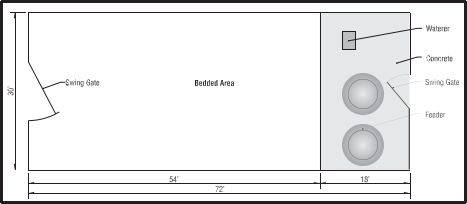
表2:生长-育肥猪大棚猪舍中典型的空间分布情况。注:炎热天气可能需要额外的饮水器。
Table 2: Space distribution in a hoop structure used for grow-finish housing. Note: In hot weather, additional waters may be added. Source: Table 1, Hoop Structures for Grow-Finish Swine, AED-41.
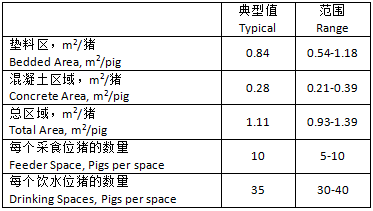
大棚猪舍猪高度以下的端墙由挡板或栏门构成。为了减少冬天的贼风,这些门可以用防水油布、镀锌钢板、回收塑料或胶合板覆盖。使用商用油布或胶合板把垫料区那一头的端墙封闭起来以减少冬天的贼风。许多生产者,特别是在美国的北部,在寒冷的天气会封闭北侧的端墙。还有一些生产者可能会在寒冷的天气关闭南北两侧的端墙。然而,将猪舍封闭的太严反而比让猪舍开放更容易造成问题。在夏天,两端都是完全开放的,把端墙的钢、塑料或胶合板拆除,以增加经过猪区域的气流。
Livestock panels or gates form the endwalls at animal level. To reduce drafts in the winter, these gates can be covered with tarps, sheets of galvanized steel, recycled plastic, or plywood. The bedded end endwalls are closed to reduce winter winds using commercially available tarps or plywood sheets. Many producers close the north end in cold weather, especially in northern climates of the United States. Some producers may close both ends in cold weather; however, closing the structure too tightly can cause more of a problem than leaving it open. In the summer, both ends are totally open, with the steel, plastic, or plywood panels removed from the end gating to increase airflow in the pig zone.
环境和通风
Environment and Ventilation
大棚结构的主要目的是保护动物不受天气影响。在夏季,此类猪舍应能提供阴凉,并通过风压进行横向通风。在冬季,此类猪舍的条件应该能进行湿度和通风控制。虽然猪舍的温度较低,但是有深层、干净、干燥的垫料,就可以让猪创造一个合适的和舒适的微环境。
The primary goal of hoop structures is to protect the animals from the weather. In the summer, the building should provide shade and allow cross ventilation by wind pressure. In the winter, the housing should allow for humidity and draft control. A cold barn with deep, clean, and dry bedding allows the pigs to create a suitable, comfortable microenvironment.
生产者可能会为了保持舍内温暖而试图限制通风。然而,限制通风会将动物产生的湿气和暖空气一起阻隔在舍内。这就造成了损害猪健康的情况。
A natural tendency is to try to restrict ventilation to keep warmed air inside the structure. However, restricting ventilation traps the moisture produced by the animals along with the warm air. This creates a situation that can damage the pig’s health.
为了减少空气质量差给动物健康带来的风险,大棚猪舍必须像任何寒冷、自然通风的猪舍结构一样加以管理。不要把猪舍封闭得太严。不要试图把此类猪舍作为一个暖气候的猪舍进行管理。这种猪舍主要是一个庇护所。动物身下的粪便会散发热量,使它们更舒适。
To reduce risks to animal health from poor air quality, hoop structures must be managed just as any cold, naturally ventilated structure. Do not close the structure too tightly. Do not attempt to manage the structure as a warm barn; it is primarily a shelter. Heat will be given off by the manure pack under the animals to help make them more comfortable.
对于任何使用自然通风的猪舍来说,风都是一个主要的通风力量,所以此类猪舍的设计要能使夏季主导风向从放置饲喂器那一端的开口进入猪舍。不要在建筑物、树木或其他大型障碍物能阻挡夏季主导风的地方建造大棚猪舍。对于大多数猪舍来说,从障碍物到建筑物末端的最小隔离距离应该是75英尺(22.86米)。
Because wind is a major force in the ventilation of any naturally ventilated structure, orient a hoop structure to intercept the prevailing summer wind through the feeder end opening. Do not construct a hoop structure where buildings, trees, or other large obstructions block the prevailing summer winds. For most structures, the minimum separation distance from obstructions to the end of the building should be 75 ft.
屋脊和侧墙开口
Ridge and Sidewall Openings
在冬季,自然通风利用不同高度的进风口来实现通风。有开放屋脊的结构可以让舍内的潮湿空气通过屋顶的开口排出去。大多数跨度较窄(12米以内)的大棚猪舍没有屋脊开口,但是现在有了防水油布,这种情况就得以改善了。根据风向,空气会沿着防水油布与侧墙处的空间进入猪舍(见图4),然后从猪舍的末端排出。因为开口是不可12r.
A structure with an open ridge will allow the moist air that builds up to escape through the opening at the top of the structure. Most narrow (<40 ft) hoop structures used for swine housing do not have ridge openings but a ridge opening tarp is now available. Ventilation air enters through a continuous space along the sidewall where the tarp is attached see Figure 4) and exits through the ends of the hoop, depending on wind direction. Because openings are not adjusted, the hoop acts mostly as a wind and snow shelter and does not maintain a set temperature.
图4:防水油布良好的固定在侧墙上。妊娠母猪大棚舍。
Figure 4: Tarp properly fastened to frame and sidewall. Source: Based on Figure 16, Hoop Structures for Gestating Sows, AED44.
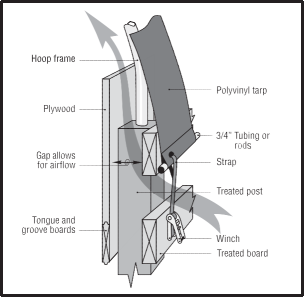
端墙通风
Endwall Ventilation
大棚猪舍依靠端墙的开口来帮助空气在猪舍内流通。一年内大部分时间端墙都是开放的。在冬季恶劣的天气下,下风口一端通常是封闭的(见图5);在冬季最严酷的天气里,进风口一端可能也会封闭。端墙顶部的开口可防止猪舍密封的太严,当端墙封闭时,这个开口有助于自然通风。栏门上会用挡风板来减少贼风,但防贼风的装置必须允许正常通风和排湿。
Hoop structures rely on endwall openings to aid air flow through the structure. The ends are open most of the year. The downwind end is usually closed during harsh conditions in the winter (See Figure 5); the upwind end also may be closed during the harshest part of the winter. A gap at the top of the endwall prevents the building from being closed up too tightly and aids in natural ventilation when the ends are closed. Where hovers or wind baffles on gating are used to reduce drafts, the draft prevention devices must still allow ventilation and moisture removal to occur.
图5:冬季大棚猪舍端墙封闭。大棚妊娠母猪舍。
Figure 5: Figure 5. Closed end of hoop during cold weather. Source: Based on Figure 13, Hoop Structures for Gestating Sows, AED44.
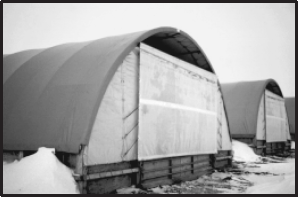
降温Cooling
大棚猪舍的设计也要考虑到夏季给猪降温,以避暑解暑。许多生产者在猪舍内安装了加湿或喷淋装置。他们把这些装置放在混凝土区域的边缘,这样风就会把水分吹过垫草区。如果这些降温装置能做到正确管理,那么目前为止并不会发生猪把垫草区弄得很脏的问题(在垫草区挖泥坑)。
Make provisions to cool the pigs for summer heat relief. Many producers add a wetting or sprinkling device. They place these devices at the edge of the concrete apron so any prevailing breeze carries the water over the bedding pack. Pigs digging mud holes in the bedding pack has not been a problem when these wetting devices are managed properly.
降温装置应该用循环定时器控制,使水有时间从猪的身体表面蒸发,以增强降温效果。降温装置务必要细心管理,以防止把垫料打湿。
Wetting of the pigs should be done using a cycle timer to allow evaporation of water from the pig’s surface to enhance the cooling effect. Careful management is necessary to prevent problems with wet bedding.
















